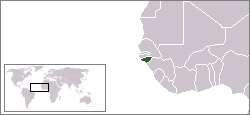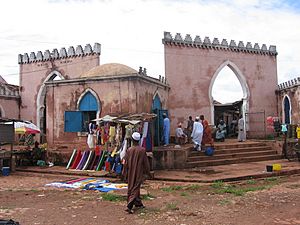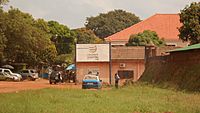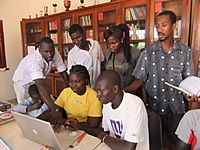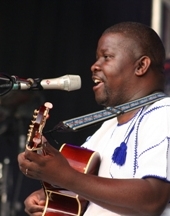Guinea-Bissau facts for kids
Quick facts for kids
Republic of Guinea-Bissau
|
|
|---|---|
|
Motto:
Unidade, Luta, Progresso "Unity, Struggle, Progress" |
|
|
Anthem:
Esta É a Nossa Pátria Bem Amada "This is Our Beloved Homeland" |
|

Location of Guinea-Bissau (dark blue) in the African Union (light blue)
|
|
| Capital and largest city
|
Bissau 11°52′N 15°36′W / 11.867°N 15.600°W |
| Official languages | Portuguese |
| Spoken languages |
List:
Guinea-Bissau Creole
English French Arabic Balanta Hassaniya Jola-Fonyi Mandinka Mandjak Mankanya Noon Portuguese Pulaar Serer Soninke |
| Ethnic groups
(2019)
|
|
| Religion
(2020)
|
|
| Demonym(s) | Bissau-Guinean Guinean |
| Government | Unitary semi-presidential republic |
| Umaro Sissoco Embaló | |
| Rui Duarte de Barros | |
| Legislature | National People's Assembly |
| Independence from Portugal | |
|
• Declared
|
24 September 1973 |
|
• Recognized
|
10 September 1974 |
| Area | |
|
• Total
|
36,125 km2 (13,948 sq mi) (134th) |
|
• Water (%)
|
22.4 |
| Population | |
|
• 2023 estimate
|
2,078,820 (150th) |
|
• Density
|
46.9/km2 (121.5/sq mi) (154th) |
| GDP (PPP) | 2023 estimate |
|
• Total
|
|
|
• Per capita
|
|
| GDP (nominal) | 2023 estimate |
|
• Total
|
|
|
• Per capita
|
|
| Gini (2021) | ▼ 33.4 medium |
| HDI (2022) | low · 179th |
| Currency | West African CFA franc (XOF) |
| Time zone | UTC (GMT) |
| Driving side | right |
| Calling code | +245 |
| ISO 3166 code | GW |
| Internet TLD | .gw |
Guinea-Bissau ( ghin-EE-_-BISS-ow; Portuguese: Guiné-Bissau; Fula: 𞤘𞤭𞤲𞤫 𞤄𞤭𞤧𞤢𞥄𞤱𞤮, romanized: Gine-Bisaawo; Mandinka: ߖߌߣߍ ߺ ߓߌߛߊߥߏ߫ Gine-Bisawo), officially the Republic of Guinea-Bissau (Portuguese: República da Guiné-Bissau), is a country in West Africa that covers 36,125 square kilometres (13,948 sq mi) with an estimated population of 2,026,778. It borders Senegal to its north and Guinea to its southeast.
Guinea-Bissau was once part of the kingdom of Kaabu, as well as part of the Mali Empire. Parts of this kingdom persisted until the 18th century, while a few others were under some rule by the Portuguese Empire since the 16th century. In the 19th century, it was colonised as Portuguese Guinea. Portuguese control was restricted and weak until the early 20th century with the pacification campaigns, these campaigns solidified Portuguese sovereignty in the area. The final Portuguese victory over the remaining bastion of mainland resistance, the Papel ruled Kingdom of Bissau in 1915 by the Portuguese military officer Teixeira Pinto, and recruited Wolof mercenary Abdul Injai was the event to solidify mainland control. The Bissagos, islands off the coast of Guinea-Bissau, were officially conquered in 1936, ensuring Portuguese control of both the mainland and islands of the region. Upon independence, declared in 1973 and recognised in 1974, the name of its capital, Bissau, was added to the country's name to prevent confusion with Guinea (formerly French Guinea). Guinea-Bissau has a history of political instability since independence.
Only about 2% of the population speaks Portuguese, the official language, as a first language, and 33% speak it as a second language. However, Guinea-Bissau Creole, a Portuguese-based creole, is the national language and also considered the language of unity. According to a 2012 study, 54% of the population speak Creole as a first language and about 40% speak it as a second language. The remainder speak a variety of native African languages. The nation is home to numerous followers of Islam, Christianity and traditional faiths, though no single religious group represents a majority of the population. The country's per-capita gross domestic product is one of the lowest in the world.
Guinea-Bissau is a member of the United Nations, African Union, Economic Community of West African States, Organisation of Islamic Cooperation, Community of Portuguese Language Countries, Organisation internationale de la Francophonie, and the South Atlantic Peace and Cooperation Zone, and was a member of the now-defunct Latin Union.
Contents
Geography
Guinea-Bissau is bordered by Senegal to the north and Guinea to the south and east, with the Atlantic Ocean to its west. It lies mostly between latitudes 11° and 13°N (a small area is south of 11°), and longitudes 11° and 15°W.
At 36,125 square kilometres (13,948 sq mi), the country is larger in size than Taiwan or Belgium. The highest point is Monte Torin with an elevation of 262 metres (860 ft). Its terrain is mostly low coastal plains with swamps of the Guinean mangroves rising to the Guinean forest–savanna mosaic in the east. Its monsoon-like rainy season alternates with periods of hot, dry harmattan winds blowing from the Sahara. The Bijagos Archipelago lies off of the mainland. The country is home to two ecoregions: Guinean forest–savanna mosaic and Guinean mangroves.
Environmental problems
Severe environmental problems include deforestation, soil erosion, overgrazing, and overfishing. Guinea-Bissau had a 2019 Forest Landscape Integrity Index mean score of 5.7/10, ranking it 97th globally out of 172 countries.
Wildlife
Economy
Guinea-Bissau's GDP per capita is one of the lowest in the world, and its Human Development Index is one of the lowest on earth. More than two-thirds of the population lives below the poverty line. The economy depends mainly on agriculture; fish, cashew nuts, and ground nuts are its major exports.
A long period of political instability has resulted in depressed economic activity, deteriorating social conditions, and increased macroeconomic imbalances. It takes longer on average to register a new business in Guinea-Bissau (233 days or about 33 weeks) than in any other country in the world except Suriname.
Guinea-Bissau has started to show some economic advances after a pact of stability was signed by the main political parties of the country, leading to an IMF-backed structural reform program.
After several years of economic downturn and political instability, in 1997, Guinea-Bissau entered the CFA franc monetary system, bringing about some internal monetary stability. The civil war that took place in 1998 and 1999, and a military coup in September 2003 again disrupted economic activity, leaving a substantial part of the economic and social infrastructure in ruins and intensifying the already widespread poverty. Following the parliamentary elections in March 2004 and presidential elections in July 2005, the country is trying to recover from the long period of instability, despite a still-fragile political situation.
Regions and sectors
Guinea-Bissau is divided into 8 regions and one autonomous sector. These are divided into thirty-seven sectors. The regions are:
* autonomous sector
Languages

Though a small country, Guinea-Bissau has several ethnic groups which are very distinct from each other, with their own cultures and languages. This is due to Guinea-Bissau being a refugee and migration territory within Africa. Colonisation and racial intermixing brought Portuguese and the Portuguese creole known as Kriol or crioulo.
The sole official language of Guinea-Bissau since independence, Standard Portuguese is spoken mostly as a second language, with few native speakers and its use is often confined to the intellectual and political elites. It is the language of government and national communication as a legacy of colonial rule. Schooling from the primary to tertiary levels is conducted in Portuguese, although only 67% of children have access to any formal education. Data suggests that the number of Portuguese speakers ranges from 11 to 15%. In the latest census (2009) 27.1% of the population claimed to speak non-creole Portuguese (46.3% of city dwellers and 14.7% of the rural population, respectively). Portuguese creole is spoken by 44% of the population and is effectively the lingua franca among distinct groups for most of the population. Creole's usage is still expanding, and it is understood by the vast majority of the population. However, decreolisation processes are occurring, due to undergoing interference from Standard Portuguese and the creole forms a continuum of varieties with the standard language, the most distant are basilects and the closer ones, acrolects. A post-creole continuum exists in Guinea-Bissau and crioulo 'leve' ('soft' creole) variety being closer to the Portuguese-language norm.
The remaining rural population speaks a variety of native African languages unique to each ethnicity: Fula (16%), Balanta (14%), Mandinka (7%), Manjak (5%), Papel (3%), Felupe (1%), Beafada (0.7%), Bijagó (0.3%), and Nalu (0.1%), which form the ethnic African languages spoken by the population. Most Portuguese and Mestiços speakers also have one of the African languages and Kriol as additional languages. Ethnic African languages are not discouraged, in any situation, despite their lower prestige. These languages are the link between individuals of the same ethnic background and daily used in villages, between neighbours or friends, traditional and religious ceremonies, and also used in contact between the urban and rural populations. However, none of these languages are dominant in Guinea-Bissau.
French is taught as a foreign language in schools, because Guinea-Bissau is surrounded by French-speaking nations. Guinea-Bissau is a full member of the Francophonie.
Religion
| Religion in Guinea-Bissau (CIA, 2020 est.) | ||||
|---|---|---|---|---|
| Religion | Percent | |||
| Islam | 46.1% | |||
| Folk religions | 30.6% | |||
| Christianity | 18.9% | |||
| Other/unaffiliated | 4.4% | |||
Various studies suggest that slightly less than half of the population of Guinea-Bissau is Muslim, while substantial minorities follow folk religions or Christianity. The CIA World Factbook's 2020 estimate stated that the population was 46.1% Muslim, 30.6% following folk religions, 18.9% Christian, 4.4% other or unaffiliated. In 2010, a Pew Research survey determined that the population was 45.1% Muslim and 19.7% Christian, with 30.9% practicing folk religion and 4.3 other faiths. A 2015 Pew-Templeton study found that the population was 45.1% Muslim, 30.9% practicing folk religions, 19.7% Christian, and 4.3% unaffiliated. The ARDA projected in 2020 the share of the Muslim population to be 44.7%. It also estimated 41.2% of the population to be practitioners of ethnic religions and 13% to be Christians.
Concerning religious identity among Muslims, a Pew report determined that in Guinea-Bissau there is no prevailing sectarian identity. Guinea-Bissau shared this distinction with other Sub-Saharan countries like Tanzania, Uganda, Liberia, Nigeria and Cameroon. This Pew research also stated that countries in this specific study that declared to not have any clear dominant sectarian identity were mostly concentrated in Sub-Saharan Africa. Another Pew report, The Future of World Religions, predicts that from 2010 to 2050, practitioners of Islam will increase their share of the population in Guinea-Bissau.
Many residents practice syncretic forms of Islamic and Christian faiths, combining their practices with traditional African beliefs. Muslims dominate the north and east, while Christians dominate the south and coastal regions. The Roman Catholic Church claims most of the Christian community.
The 2021 US Department of State Report on International Religious Freedom mentions the fact that leaders of different religious communities believe that the existing communities are essentially tolerant, but express some concerns about rising religious fundamentalism in the country. An incident in July 2022, when a Catholic Church in the overwhelmingly Muslim region of Gabú was vandalised, raised concern amongst the Christian community that Islamic extremism might be infiltrating the country. However, there have been no further similar incidents, and no direct links to Islamic extremists have surfaced.
Climate
Guinea-Bissau is warm all year round with mild temperature fluctuations; it averages 26.3 °C (79.3 °F). The average rainfall for Bissau is 2,024 millimetres (79.7 in), although this is almost entirely accounted for during the rainy season which falls between June and September/October. From December through April, the country experiences drought.
Education
Education is compulsory from the age of 7 to 13. Pre-school education for children between three and six years of age is optional and in its early stages. There are five levels of education: pre-school, elemental and complementary basic education, general and complementary secondary education, general secondary education, technical and professional teaching, and higher education (university and non-universities). Basic education is under reform, and now forms a single cycle, comprising six years of education. Secondary education is widely available and there are two cycles (7th to 9th classe and 10th to 11th classe). Professional education in public institutions is nonoperational, however private school offerings opened, including the Centro de Formação São João Bosco (since 2004) and the Centro de Formação Luís Inácio Lula da Silva (since 2011).
Higher education is limited and most prefer to be educated abroad, with students preferring to enroll in Portugal. A number of universities, to which an institutionally autonomous Faculty of Law as well as a Faculty of Medicine that is maintained by Cuba and functions in different cities.
Child labor is very common. The enrollment of boys is higher than that of girls. In 1998, the gross primary enrollment rate was 53.5%, with higher enrollment ratio for males (67.7%) compared to females (40%).
Non-formal education is centered on community schools and the teaching of adults. In 2011, the literacy rate was estimated at 55.3% (68.9% male, and 42.1% female).
Culture
Music
The music of Guinea-Bissau is usually associated with the polyrhythmic gumbe genre, the country's primary musical export. However, civil unrest and other factors have combined over the years to keep gumbe, and other genres, out of mainstream audiences, even in generally syncretist African countries.
The cabasa is the primary musical instrument of Guinea-Bissau, and is used in extremely swift and rhythmically complex dance music. Lyrics are almost always in Guinea-Bissau Creole, a Portuguese-based creole language, and are often humorous and topical.
The word gumbe is sometimes used generically, to refer to any music of the country, although it most specifically refers to a unique style that fuses about ten of the country's folk music traditions. Tina and tinga are other popular genres, while extent folk traditions include ceremonial music used in funerals, initiations, and other rituals, as well as Balanta brosca and kussundé, Mandinga djambadon, and the kundere sound of the Bissagos Islands.
Cuisine
Common dishes include soups and stews. Common ingredients include yams, sweet potato, cassava, onion, tomato, and plantain. Spices, peppers, and chilis are used in cooking, including Aframomum melegueta seeds (Guinea pepper).
Film
Flora Gomes is an internationally renowned film director; his most famous film is Nha Fala (English: My Voice). Gomes's Mortu Nega (Death Denied) (1988) was the first fiction film and the second feature film ever made in Guinea-Bissau. (The first feature film was N’tturudu, by director Umban u’Kest in 1987.) At FESPACO 1989, Mortu Nega won the prestigious Oumarou Ganda Prize. In 1992, Gomes directed Udju Azul di Yonta, which was screened in the Un Certain Regard section at the 1992 Cannes Film Festival. Gomes has also served on the boards of many Africa-centric film festivals. The actress Babetida Sadjo was born in Bafatá, Guinea-Bissau.
Sports
Football is the most popular sport in Guinea-Bissau. The Guinea-Bissau national football team is controlled by the Federação de Futebol da Guiné-Bissau. They are a member of the Confederation of African Football (CAF) and FIFA.
Images for kids
-
Bridge in São Vicente, Cacheu
-
Rare salt water Hippopotamuses in Orango Island]]
See also
 In Spanish: Guinea-Bisáu para niños
In Spanish: Guinea-Bisáu para niños




